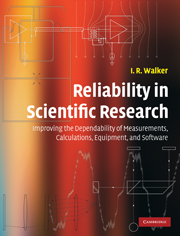 Reliability in Scientific Research
Reliability in Scientific Research Published online by Cambridge University Press: 05 June 2012
Introduction
A number of basic qualities or conditions are of value whenever reliability is an issue. These include: (a) simplicity, (b) redundancy (providing duplicate or backup components or systems), (c) margins of safety, (d) modularity (dividing complicated things into simple components), and (e) conservatism (using conservative technology). These factors, and others, are considered in the following chapter.
Human error is, of course, a very important cause of problems in all activities. It might be thought that little can be done to prevent such errors, but this is far from the case. For example, numerous investigations have been carried out (mostly in the aviation and nuclear industries), which show that errors are generally not completely random and unpredictable events, but usually follow regular patterns. These results, which are discussed below, suggest ways of avoiding errors, or at least mitigating their consequences.
Other sections of the chapter discuss record keeping in the laboratory (the lack of which is a common cause of problems), the maintenance and calibration of equipment, and general strategies for troubleshooting apparatus and software.
Central points
The following are very general principles of reliability that recur repeatedly in all activities in research.
To save this book to your Kindle, first ensure [email protected] is added to your Approved Personal Document E-mail List under your Personal Document Settings on the Manage Your Content and Devices page of your Amazon account. Then enter the ‘name’ part of your Kindle email address below. Find out more about saving to your Kindle.
Note you can select to save to either the @free.kindle.com or @kindle.com variations. ‘@free.kindle.com’ emails are free but can only be saved to your device when it is connected to wi-fi. ‘@kindle.com’ emails can be delivered even when you are not connected to wi-fi, but note that service fees apply.
Find out more about the Kindle Personal Document Service.
To save content items to your account, please confirm that you agree to abide by our usage policies. If this is the first time you use this feature, you will be asked to authorise Cambridge Core to connect with your account. Find out more about saving content to Dropbox.
To save content items to your account, please confirm that you agree to abide by our usage policies. If this is the first time you use this feature, you will be asked to authorise Cambridge Core to connect with your account. Find out more about saving content to Google Drive.